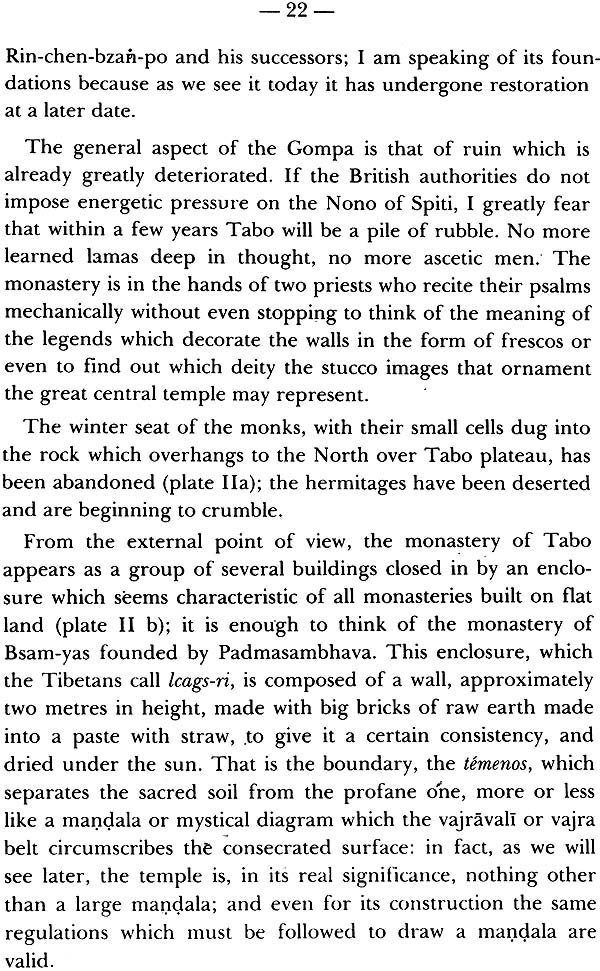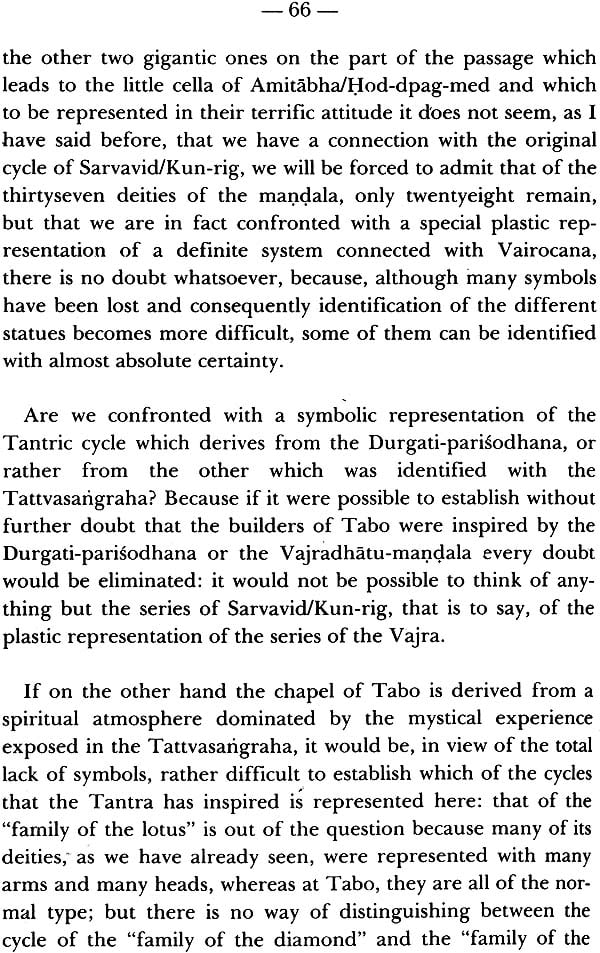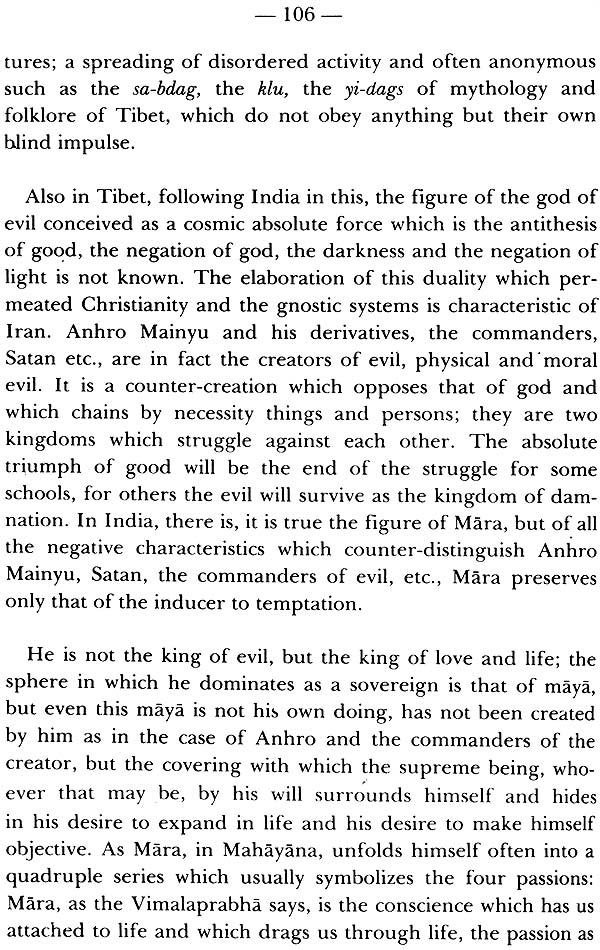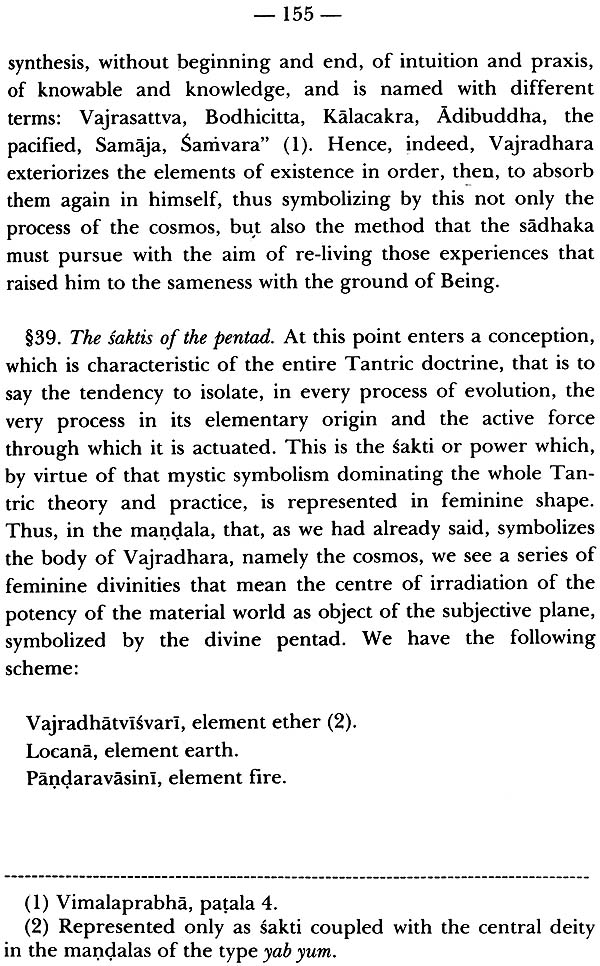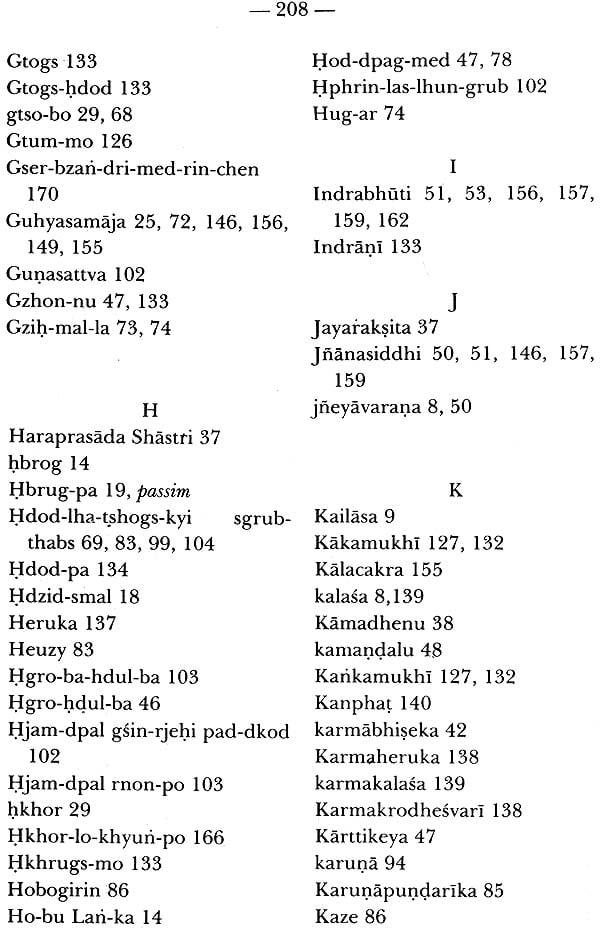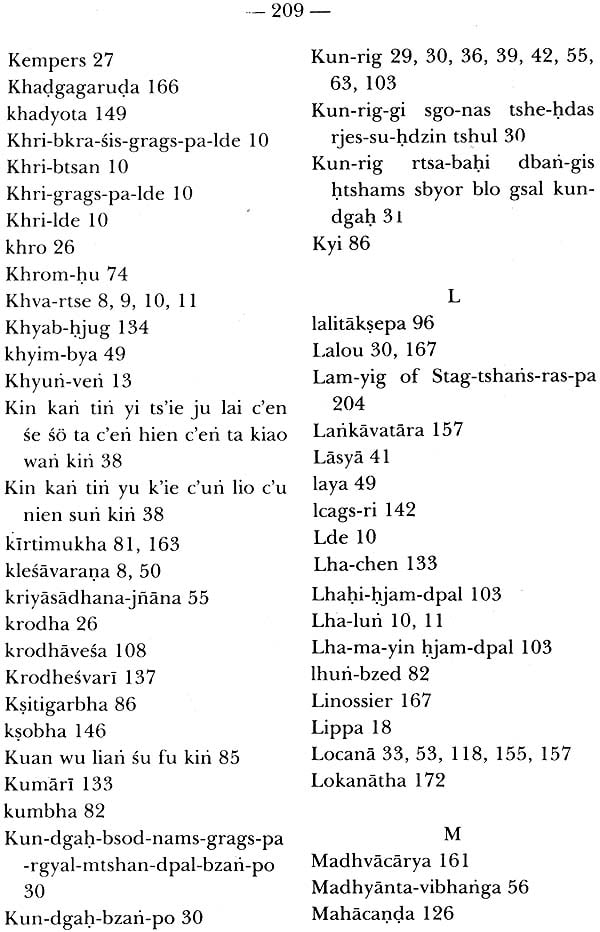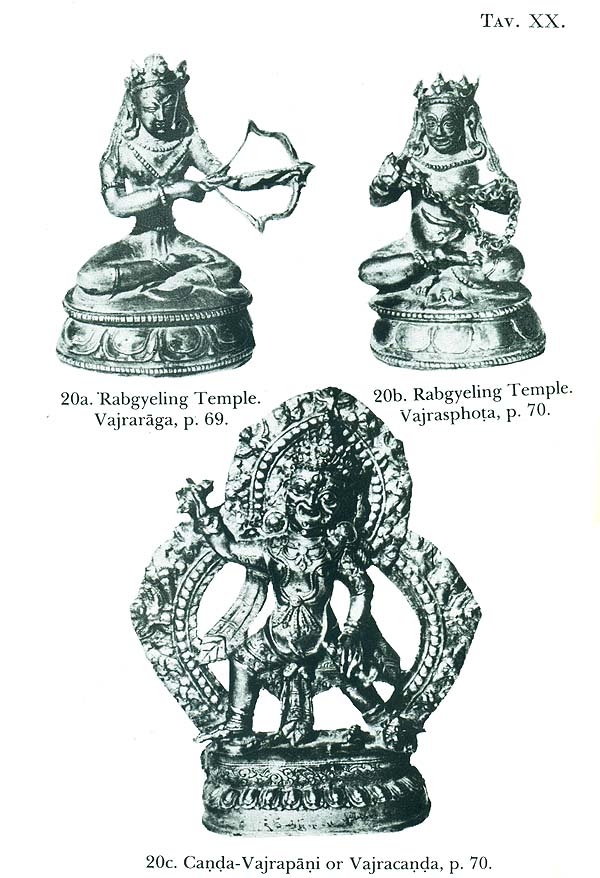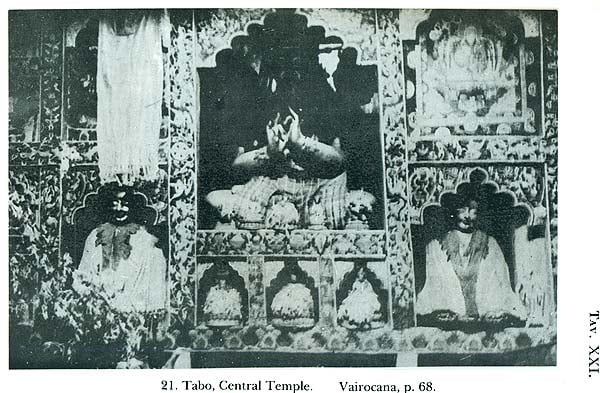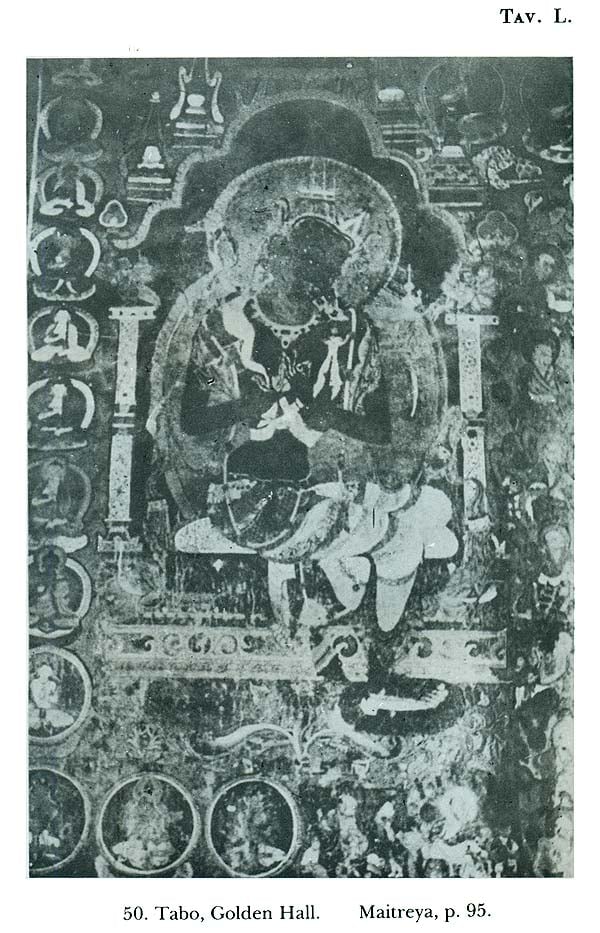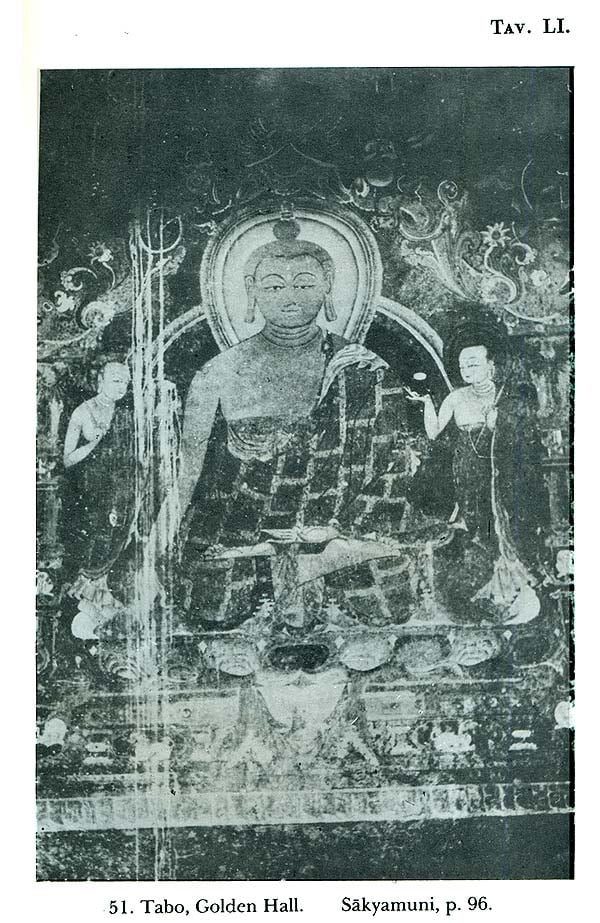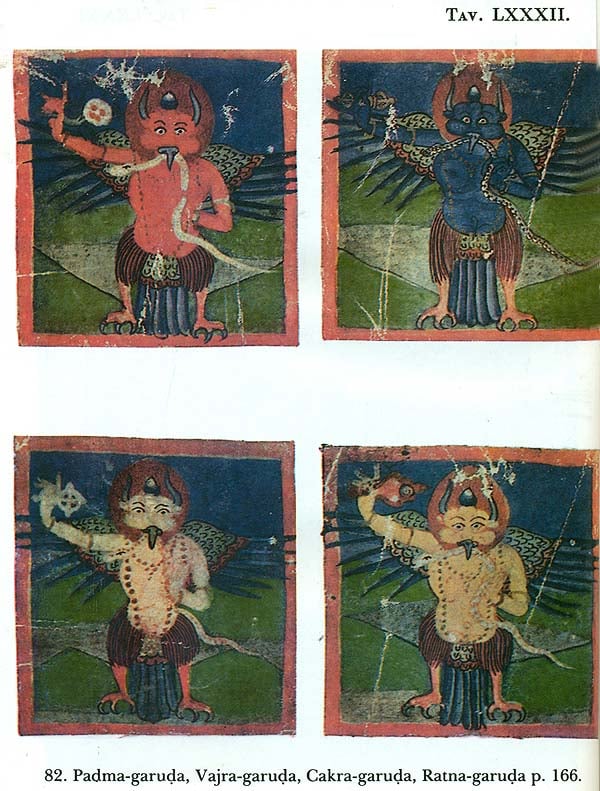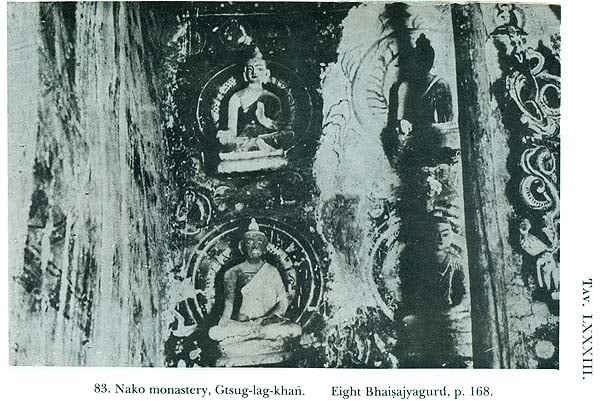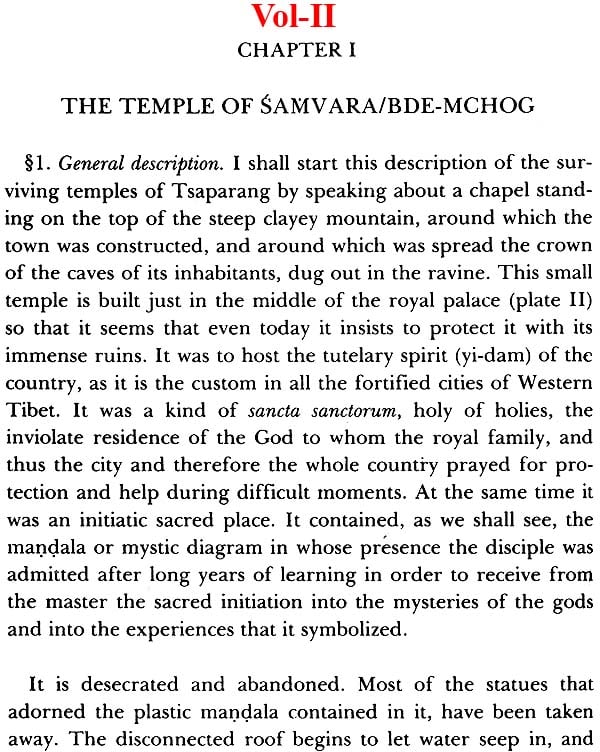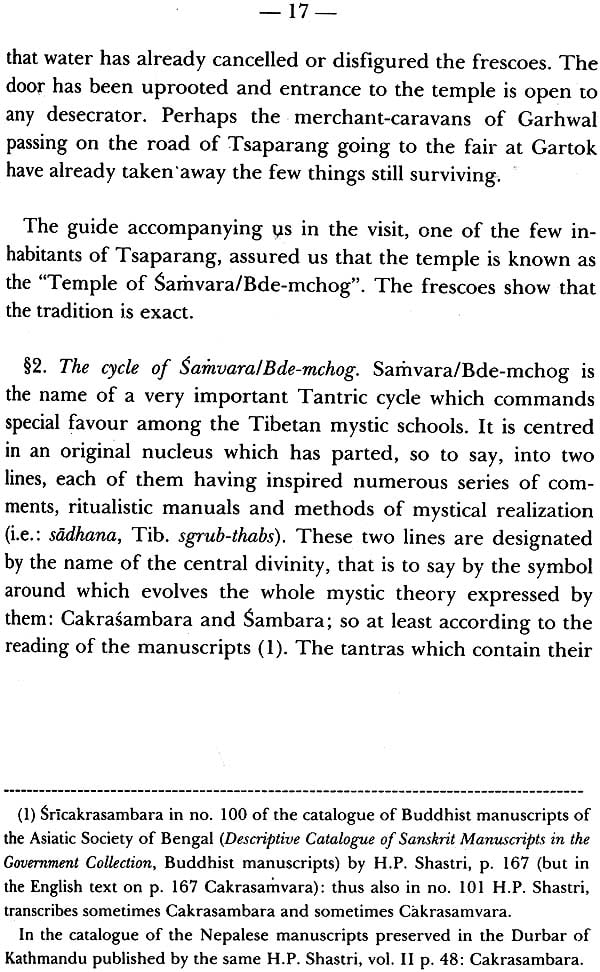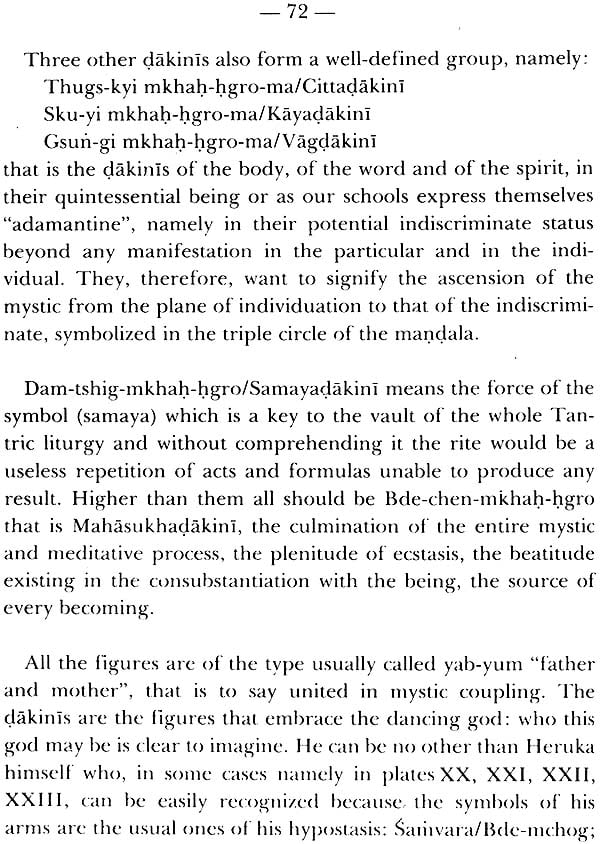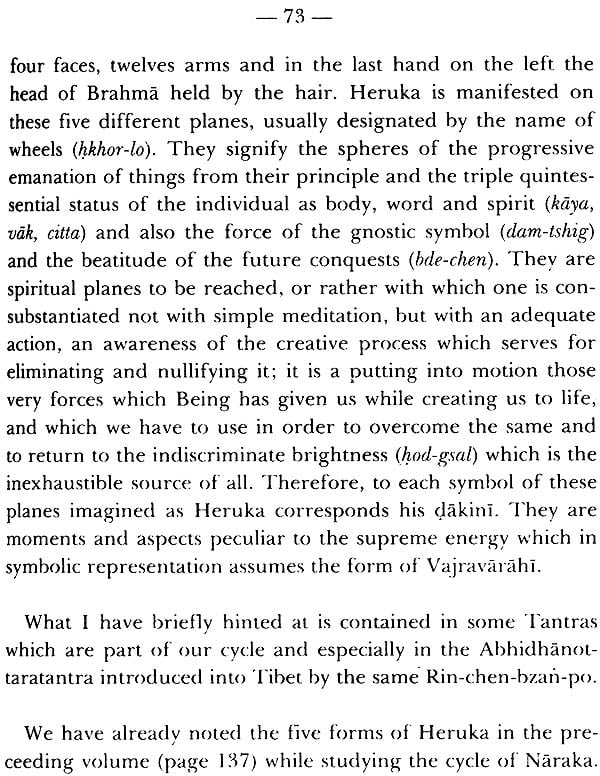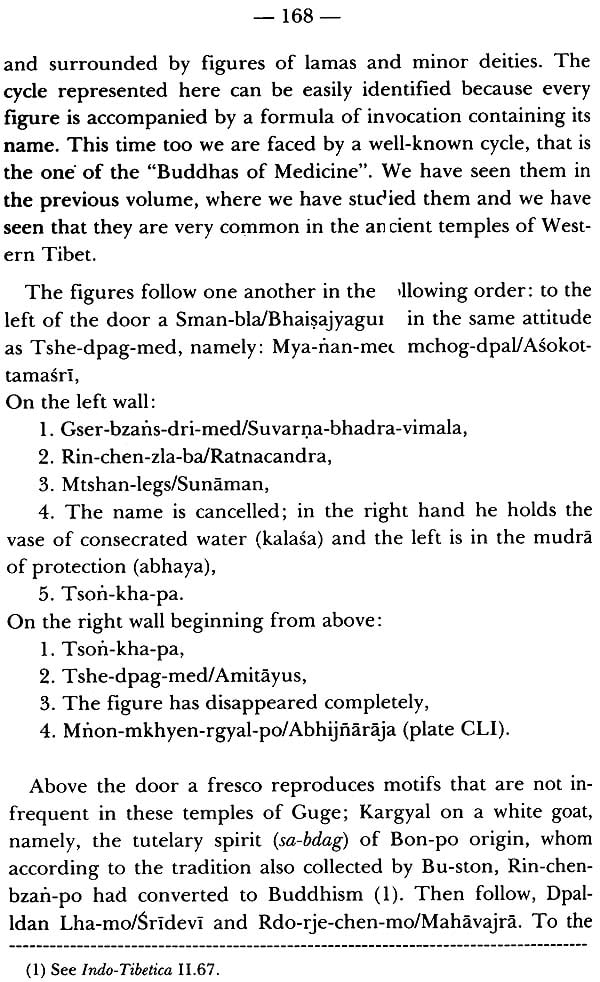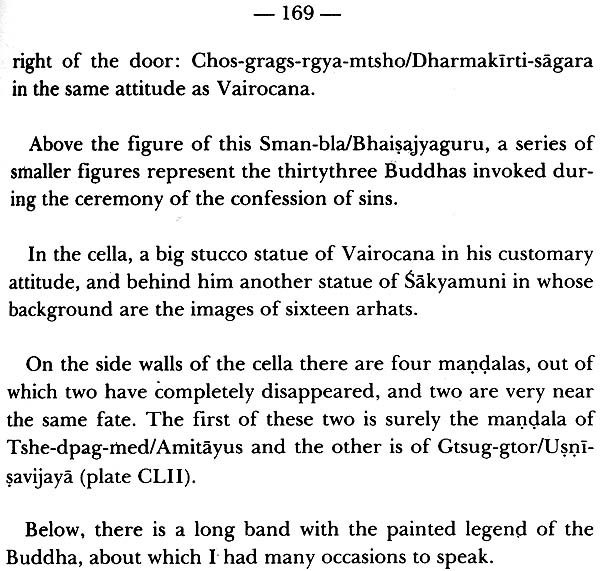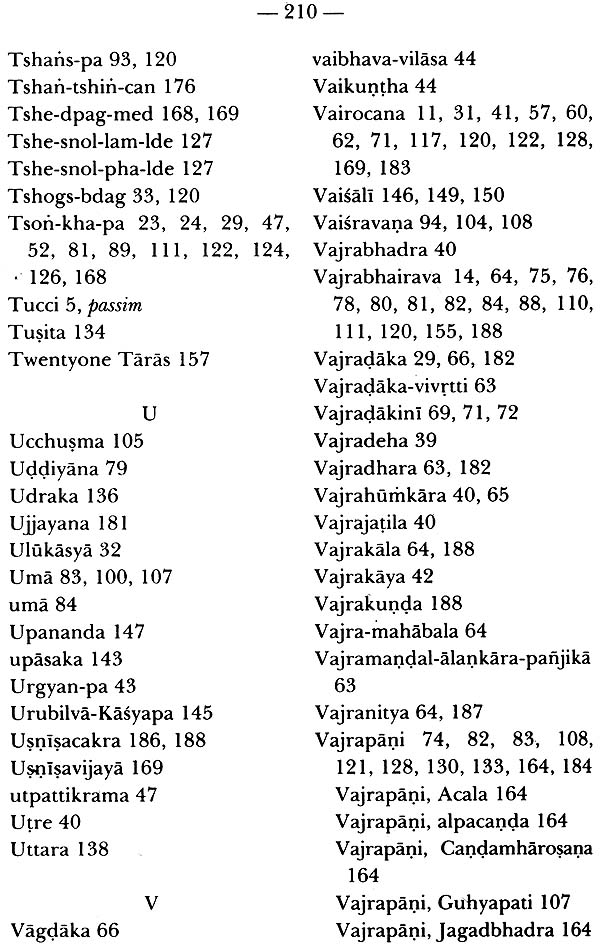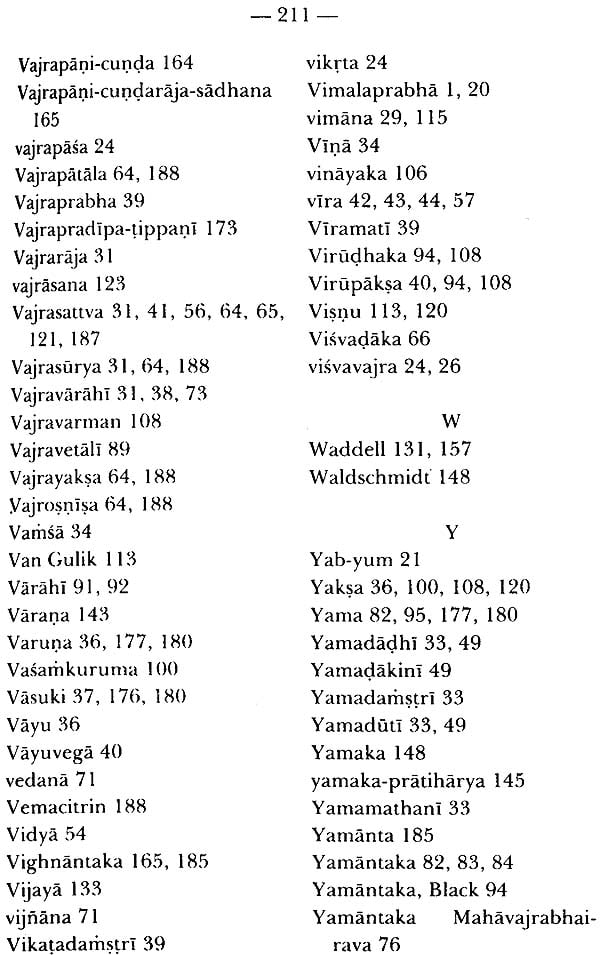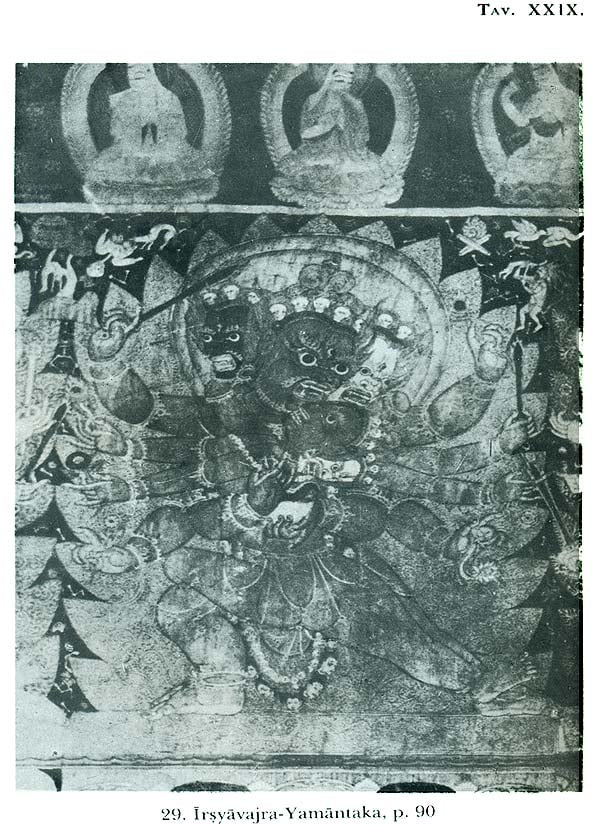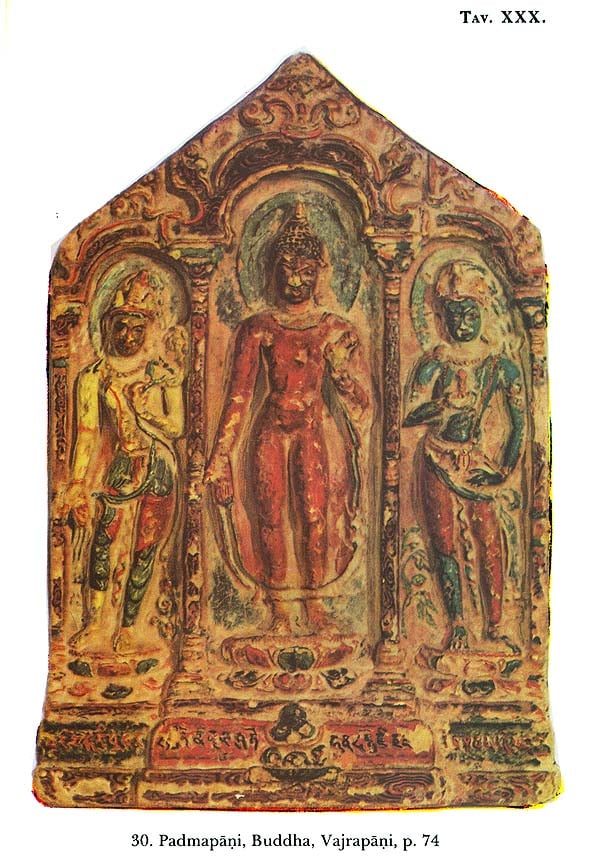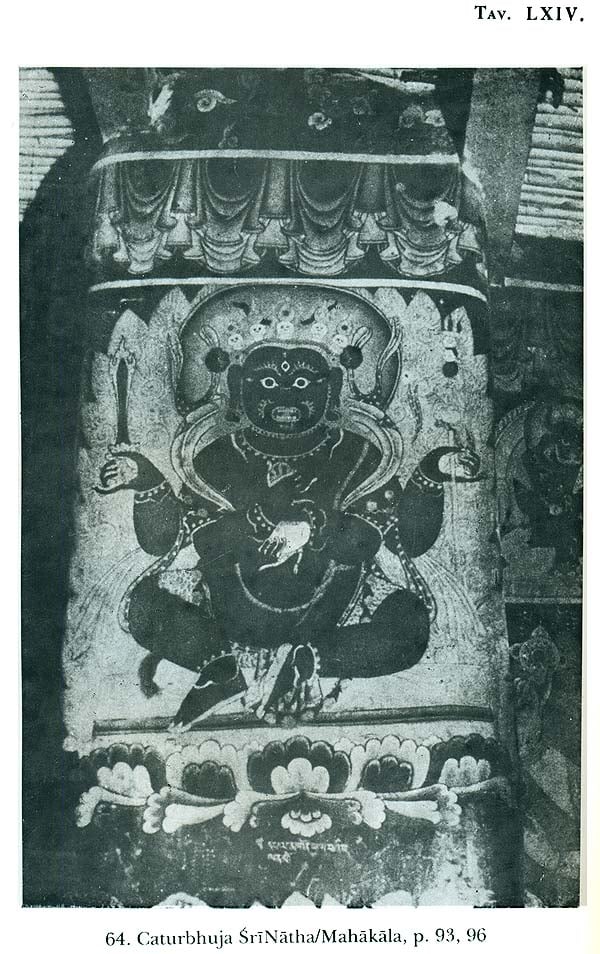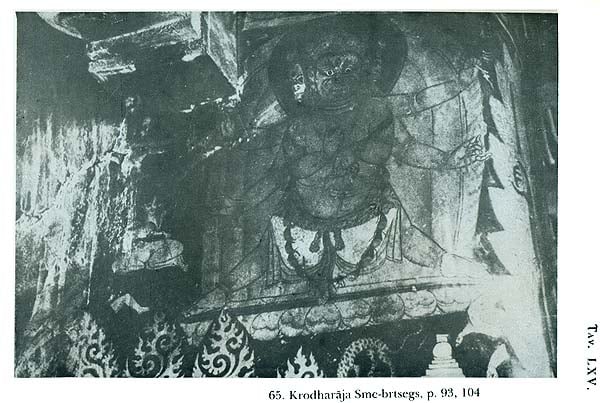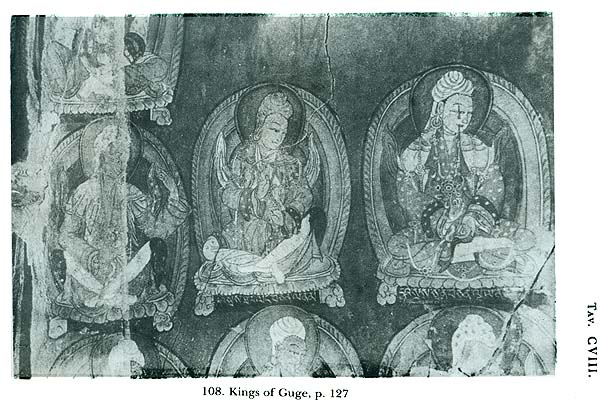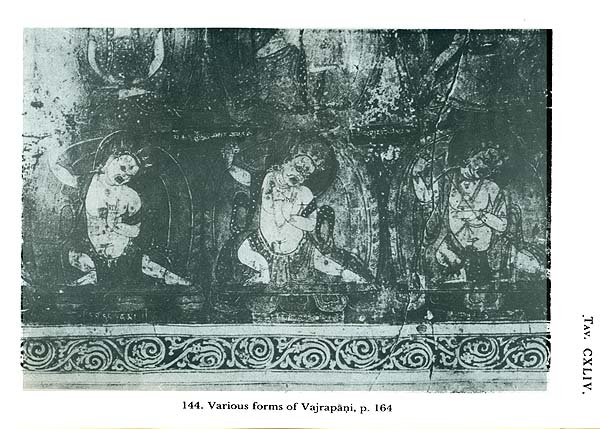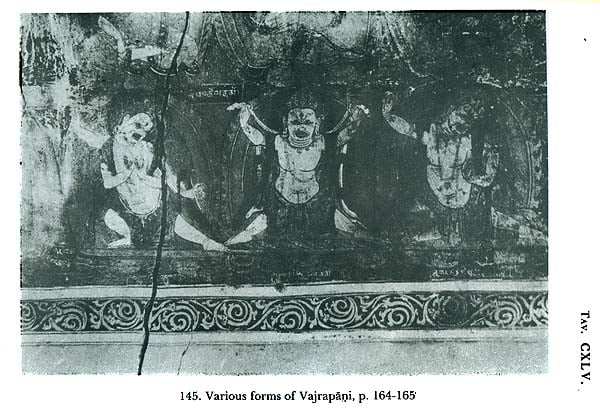
The Temples of Western Tibet and Their Artistic Symbolism (In Two Volumes)
Book Specification
| Item Code: | NAN120 |
| Author: | Lokesh Chandra |
| Publisher: | Aditya Prakashan |
| Language: | English |
| Edition: | 1988 |
| ISBN: | PartI: 8185179220 Part-II: 8185179239 |
| Pages: | 579 (3 Color and 75 Pages B/W Illustrations) |
| Cover: | Hardcover |
| Other Details | 9.5 inch X 6.5 inch |
| Weight | 1.70 kg |
Book Description
Fundamental studies on Tibetology are incorporated in the four volumes (seven bindings) of Professor Giuseppe Tucci' s Indo- Tibetica. As the work appeared in Italian, very few scholars have benefited by the' crucial results of Tucci' s investigations and perceptions. Moreover, Indologists hardly ever approached it, as Tucci used Tibetan terms like mchod-rten for stupa. The presented English version of the Indo- Tibetica will place at the disposal of Indologists, Tibetologists, Buddhologists, Historians, Anthropologists, Archaeologists and specialists in allied areas and disciplines, a basic work which presents new material from unpublished sources and unexplored monasteries on the frontiers of India and in bordering areas. Sanskrit equivalents of Tibetan terms have been used throughout to make the text accessible to a wider audience, for example, stupa (mchod-rten).
This volume describes the ancient monasteries of Spiti and Kunavar, namely, those at Tabo, Lhalung, Chang and Nako. Prof. Tucci has identified the paintings of mandal as and individual deities in the temples and elucidated their symbolism at length. The abundance of mystic meanings of the deities and cycles represented is interpreted from Sanskrit and Tibetan texts. The first chapter details the main temple of the monastic complex of Tabo, dedicated to the Vajradhatu mandala, The second describes the Gserkhan or Golden Temple of Tabo. Its walls are covered with ancient frescoes that go back to the 16th century. The Dkyil-khan or Mandala Temple constitutes the third chapter. Its paintings are from the 17th century. Chapter IV is devoted to the minor temples at Tabo. The next three chapters V, VI and VII take up the temples at Lhalung, at Chang, and at Nako. The Nako temple has frescoes of the 14-15 century.
This volume is of unique importance to understand the fundamentals of Vajrayana art as a concomitant of mysteriosophic realisation. Prof. Tucci has propounded the symbolic and esoteric meaning of the mandalas at length, and in depth which is unique to him. Two Kahsmiri wooden sculptures of 10-11 th century in the Tabo Gtsug-lag-khanare valuable for the history of Indian art.
A detailed preface by Lokesh Chandra throws further light on the mandalas of Vairocana, which dominate the temples in this volume. He clarifies the various types of these mandalas which had posed problems of Tucci. The murals of Nor-bzan had escaped identification by Tucci, but have now been concorded to Sudhana of the Gandavyuha. The role of photism in the evolution or Tantras is discussed.
This work calls for further field exploration and table research, on the extant sutras and chronicles, and on the murals and sculptures in the ancient territories of Guge.
Prof. GIUSEPPE TUCCI (1894-1984) is the doyen of modern scientific studies of Tibetan arts and thought, history and literature. He was for many years Professor of Religions and philosophies of India and the Far East at the University of Rome. He also taught at universities in India. Professor Tucci made several visits to Nepal and has been on eight expeditions to Western and Central Tibet, collecting historical, artistic and literary material. His scientific expeditions resulted in many historical books, like the Tibetan Painted Scrolls and the seven volumes of Indo- Tibetica in Italian. Prof. Tucci gives word to the mute dialogue of the mind with the mysterious presences in the Land of Snows.
The General Editor of the series of Prof. LOKESH CHANDRA who is a renowned scholar of Tibetan, Mongolian and Sino- Jananese Buddhism. He has to his credit over 360 works and text editions. Among them are classics like his Tibetan-Sanskrit Dictionary, Materials for a History of Tibetan Literature, Buddhist Iconography of Tibet, and his ongoing Dictionary of Buddhist Art in about 20 Volumes. Prof. Lokesh Chandra was nominated by the President of the Republic of India to the Parliament in 1974-80 and again in 1980-86. He has been a Vice- President of the Indian Council for Cultural Relations, Chairman of the Indian Council of Historical Research Presently: Director, International Academy of Indian Culture.
This volume III.I of the Indo-Tibetica describes the ancient monasteries of Spiti and Kunavar, namely, those at Tabo, Lhalung, Chang and Nako. Prof. Tucci has identified the paintings of mandalas and individual deities in the temples and elucidated their symbolism at length. Usually he names the iconography of the central wall, then of the left wall and finally of the right wall. At times this scheme has to be discovered in the rich wealth of detail, and the bountiful abundance of mystic meanings of the deities and cycles represented. The introduction gives a synoptic view of the monastic centres in a threadbare clarity that can lead the reader to the overflowing poesy of Tucci's interpretation.
The monastic complex at Tabo has eight temples enclosed by a boundary wall (p.24). Among them, three temples are important from the artistic and historical standpoint:
Central temple or Gtsug-Iag-khari Golden temple or Gser-khari Mandala temple or Dkyil-khan.
The Gtsug-lag-khan has the Vajradhatu-mandala of Vairocana, as was the preference for mandalas of Vairocana in the school of Rin-chen-bzan-po. Life-size stucco images of deities of the mandala are set around the walls, with a central fourfold image of Vairocana. Beneath the stucco statues are the frescos of the life of Sakyamuni on the right wall and on the left wall of the pilgrimage of Sudhana which is dealt with at length in the Gandavyuha, a surra of the Avatamisaka school.
Beyond the fourfold image of Vairocana and the stucco images of the Vajradhatu-mandala, at the far end we enter a cella. The central statue in the cella is that of Amitabha (p.78). Tucci brings in the Five Buddhas. Here Amitabha is on his own and does not belong to the quinary system of the Five Buddhas. He is surrounded by four acolytes: Avalokita, Mahasthama-prapta, Ksitigarbha and Akasagarbha. There is a parallel to this scheme at the Horyuji monastery in Japan.
Chapter II describes the Gser-khari or Golden Temple of Tabo. The walls are covered with ancient frescos that go back to the 16th century. The depictions on the walls are as follows: Left wall: a) Bhaisajyaguru, b) Amitabha flanked by Avalokita and Mahasthamaprapta, c) Vajradhara.
Central wall: a) Maitreya, b) Sakyamuni surrounded by Sixteen Arhats, c) Manjusri.
Right wall: a) Sarvavid Vairocana encircled by the Thirtyseven Deities in medallions, b) Green Tara, c) Vijaya.
Chapter III takes up the Dkyil-khan or Mandala Temple. It has been modernised. The paintings pertain to the 17th century. It was used for invitiation rites/abhiseka. The central figure is of Sarvavid Vairocana surrounded by deities in medallions. On the left wall is a mandala of Aksobhya. The right wall has a mandala whose central' deity is erased. This temple has paintings of a historical character. To the left of the door are paintings of Byan-chub-hod, Zhi-ba-hod and Ye-ses-hod. The panoramic view of the monasteries of Tholing and Tabo is painted on the right of the central wall and also bears an inscription.
Chapter IV is devoted to the minor temples at Tabo. Among them, the Byams-pa lha-khari "Maitreya temple" has a recent statue of Maitreya. The smaller Hbrom-ston temple has an ancient door of deodar wood of the 12th century. The larger Hbrom-ston temple is empty. It has paintings of the eight Bhaisajyaguru going back to the 17th century. The Lha-khan dkar-byun is insignificant.
Chapter V describes the temple at Lhalung. The left wall has a mandala of eight-armed Vairocana attended by sixteen deities (four Tathagatas and twelve goddesses). The central wall has Vagisvara Manjusri with four attendant deities to the left, and Maitreya with his parivara of four deities to the right. The right wall shows Prajnaparamita.
Chapter VI takes up the Temple of Chang in Upper Kunavar. The central wall has a big figure of Sakyamuni, with deities of the Naraka mandala all around. Two small frescos to the left of the door may be connected with the foundation of the temple.
Chapter VII describes the monastery at Nako with four small temples enclosed by a boundary wall. Temple no. 1 is recent. Temple no. 2 has stucco images of the Parica-tathagata. Tucci gives the mystical meaning of the pentad at length. On the left wall is Prajnaparamita and on the right wall is the mandala of Sarvavid Vairocana. The central figure of Temple no. 3 is Yellow Tara with the images of Eight Bhaisajyaguru on the sides. The mandala on the left wall has disappeared. The right wall has the mandala of Vairocana. Besides the monastic complex, Nako has a temple of Padmasambhava. It had paintings of the 14-15th century, of whom only four are better preserved on the left wall, faint traces of a mandala can be seen on the central wall, and the right wall has Amitayus, Sakyamuni and Amitabha.
This volume is of unique importance to understand the fundamentals of Vajrayana art as a concomitant of mysteriosophic realisation. Prof. Tucci has propounded the symbolic and esoteric meaning of the mandala, or cycle as he terms it, not only at length, but in depth which is unique to him and inimitable. In the depth of visualisation the individual becomes a dynamited centre. As a new centrum, he envisions and creates, leading to new concatenations, to new mandalas. The broad outlines remain, but new cycles emerge. Their manifestation is art, which baffles scholars who seek uniform systems. Naturally, symbolism dominates this perceptive work of Tucci. It imparts a living dimension to ancient statues in the round and to the two-dimensional frescos on the walls of monasteries.
§ 1. The Historical Geography of Western Tibet. In the second volume of Indo- Tibetica, specially devoted to Rin-chen-bzari-po (1), I believe I have thrown some light on the importance of the work developed around the year 1000 by this great missionary and apostle of Buddhism in Western Tibet and also to have established the role which in the Renaissance of Lamaism, is verified during that period of time in the Land of Snows, in the province of Guge and its kings. I have also shown that Rin- chen-bzan-po was not only a great translator who introduced new texts of dogma and mysticism into Tibet and a master of spiritual experience until then unknown to the inhabitants of his land, but also that he wants to be remembered as one of the most tireless builders of temples and sacred buildings that Tibet has ever known. His name will remain forever connected to one of the most important periods in the history of Tibetan art.
His biography and other Tibetan historical works have preserved for us the list of monuments erected by his extremely noble figure of the newly-born Lamaism; but, as I said in the aforementioned volume, it was difficult, with our extremely scarce geographical knowledge of Western Tibet, to identify exactly every place which tradition connected in some way with Rin-chen-bzari-po and in which at one time an intellectual, religious and artistic life of such quality took place, in a region which has been today almost completely abandoned. It was necessary to go to the place, to inspect the site, to collect first-hand information from people, to verify my previous identifications and above all to explore the region archaeologically, to collect the artistic material, manuscript, iconographic and epigraphic material of the period and to visit one by one the temples attributed to Rin-chen-bzari-po and erected by the Guge kings and to see how much light these and the documents preserved there could still throw on the great activity of thought and art which during the time of Ye-ses-hod and his successors developed in the Himalayas between Spiti and the Manasarovar lake. It was in fact with this purpose that the Accademia d'Italia entrusted to me, under the high patronage of the Duce, the command of a new expedition into Western Tibet, to the success of this the enlightened interest of the British authority in India also contributed, since they well understood the importance of my trip and were generous with their assistance and, for a start, managed to obtain for me the permit to cross the Tibetan frontier, a privilege, as is well-known, granted to very few.
In this manner I managed not only to verify the purely literary data preserved in these historical and biographical •works, but to collect a vast amount of material which I will be publishing and illustrating regularly in this series. This is not only of interest to the political, religious and artistic history of Guge, but contributes to a better and more precise knowledge
of Lamaism and of its many aspects which are even now partially unkown. But all this has been said in the report on the trip already published by the Reale Accademia- d'Italia (Royal Academy of Italy) and I ask those who are interested in further details about the itinerary followed and the happenings during our expedition to consult it.
I should rather re-start the study of the list of temples attributed to Rin-chen-bzari-po published by me in Volume 11 of Indo-Tibetica. The first thing that I have been able to establish is that a geographical identification of many of them must be correct; many places, connected by means of oral and literary tradition with the great apostle, are completely unknown to Europeans and are not marked on the map, not even in that of the Survey which are doubtlessly the best. And in fact on the basis of the results of my trip of 1933, I re-examined the list of the chapels which the biography attributes to Rin-chen-bzari-po and I corrected, with the new and incontestable documentation, some of the identifications proposed by me beforehand.
The research is necessarily very technical, but it will seem all the more interesting when we think that Western Tibet is on the road to progressive depopulation and that the reconstruction of the historical geography of the region, difficult today, will in very little time be practically impossible.
| Preface | ||
| Synoptic view of the Book | xiii | |
| Twentyfour mandalas of STTS (4 samayas and 5 Kulas) | xvii | |
| The eighteen systems of Vajrasekhara yoga | xxiv | |
| Types of Mandalas of Vairocana | xxix | |
| Legend of Sudhana from the Avatamsaka sutra Gandavyuha (Rocana toVairocana) | xxxiv | |
| Amitabha and Amitayus | xxxvii | |
| Bhaisajyaguru | xlii | |
| Mara | xlii | |
| Literature cited | xliv | |
| Contents of the Main Book | ||
| 1 | The Historical Geography of Western Tibet | 5 |
| 2 | Diffusion of Sects | 17 |
| Chapter I Tabo. The Gtsug-lag-khan | ||
| 1 | General aspects of the Monastery | 21 |
| 2 | The Interior of the Gtsug | 25 |
| 3 | The Statues of the Gtsug-lag-khan represent a Tantric cycle of Vairocana | 28 |
| 4 | Some Tibetan sources on the cycle of Sarvavid Vairocana | 30 |
| 5 | The iconographical description of the thirty sevendeities of sarvavid | 32 |
| 6 | Indian sources of the cycle of Sarvavid and similar cycles | 36 |
| 7 | The Mandala of Vairocana according to Tattva sangraha | 39 |
| 8 | The Five mystical families and the five cycles | 42 |
| 9 | The Family of the gem (ratna -kula) | 43 |
| 10 | The Family of the lotus (Padma-kula) | 46 |
| 11 | The symbolic and esoteric meaning of the Mandala | 49 |
| 12 | The Significance of the Mandala of Sarvavid according to Tson-kha-pa | 55 |
| 13 | The main Mandala of Vairocana | 59 |
| 14 | Which cycle of Vairocana is represented in Tabo | 62 |
| 15 | Identification of the individual status | 68 |
| 16 | Iconographic types of Vairocana | 68 |
| 17 | Age of the Paintings at Tabo | 72 |
| 18 | The frescos | 75 |
| 19 | The Cella and Iconographic types of the Five Buddhas | 78 |
| 20 | Amitabha and Amitayus | 82 |
| 21 | Acolytes of Amitabha | 84 |
| 22 | The Library of Tabo | 86 |
| 23 | Two Kashmiri Sculptures | 89 |
| Chapter II Tabo. The Gser-Khan (Golden Hall) | ||
| 24 | The Gser-Khan and its paintings | 91 |
| 25 | Methods and meanings of Tantric evocations | 97 |
| 26 | The dharmapala and the Terrific in Tantric School | 105 |
| Chapter III Tabo. The Dkyil-Khan (Mandala Hall) | ||
| 27 | The Initiation Chapel | 109 |
| 28 | The Paintings of Historical Characters | 111 |
| Chapter IV Tabo. The Minor Chapels | ||
| 29 | Minor Temples | 114 |
| Chapter V Lhalung | ||
| 30 | New Cycle of Vairocana Represented at Lhalung | 116 |
| 31 | The central wall | 118 |
| 32 | The Prajnaparamita | 120 |
| Chapter VI The Temple of Chang (High Kunavar) | ||
| 33 | The Cycle of Naraka or of the Internal Deities | 122 |
| 34 | The Cycle of Naraka on Thankas | 135 |
| 35 | Minor Paintings | 138 |
| Chapter VII Nako | ||
| 36 | The Gompa Attributed to Rin-chen-Bzan-po | 141 |
| 37 | Mystical meaning of the Supreme Pentad | 145 |
| 38 | Equivalences of the Pentad | 151 |
| 39 | The Saktis of the Pentad | 155 |
| 40 | The Temples as Mandalas | 159 |
| 41 | Ornamental motifs of the type of Tibetan Garuda | 162 |
| 42 | The Bhaisajyaguru/Saman-bla or the Gods of Medicine | 162 |
| 43 | The Temple of Padmasambhava | 172 |
| Appendices | ||
| I | From a Manuscript of Pranjnaparamita | 177 |
| II | From a Manuscript of Durgati-Parisodhana | |
| III | From a Manuscript of Lokaprajnapati | 178 |
| IV | From a Fragmentary Manuscript | 179 |
| V | From the chronicles of the Fifth Dalai Lama Dza 46 | |
| VI | The Mandala of Sarvavid | 189 |
| VII | The Forty-Eight Goddesses of | 191 |
| VIII | Inscriptions of Tabo (Text) | 195 |
| IX | Inscriptions of Tabo (Translation) | 198 |
| Index | ||
| Plates I-XCI | ||
| Map of Diffusion of Sects | ||
| Map of the Valley of chandra and Spiti |
SYNOPTIC VIEW OF THE BOOK This volume of the Indo-Tibetica is dedicated to the six temples of Tsaparang, the first two named after their central deity namely Samvara and Vajrabhairava and the remaining four termed by their general characteristics: the White Temple, the Red Temple, the Temple of the Prefect, and the Lo-than dgonpa. These temples are unique examples of early Tibetan mural paintings as well as sculptures, all direct derivations from Indian traditions, and some of them even from the brush of Indian masters. In the feminine deities frescoed on the walls we can discern the continuation of the tradition of Indian miniatures. Professor Tucci speaks at length about the importance of the art of the chapels of Tsaparang in his introduction. He discusses the evident traces of Indian inspiration in the accuracy of execution, the delicacy of drawing, chiaroscuro effects, figures in profile rather than in frontal aspects, and so on. The art of Tsaparang has unique importance for the last phase of Buddhist art in India, especially in its Kashmiri idiom. The vanishing murals and images of the great Kashmiri monasteries evoked the admiration of Somendra the son of Ksemendra as early as the eleventh century. Already then, the light of Buddhism and its artistic glories were flickering out in Kashmir. Ksernendra set himself to capture the moral purity, enlightenment and beauty of the fading cloister walls in the varied flow of metres in the Avadana-kalpalata, as his son Somendra says in the l08th chapter:
"Gone are the monasteries in the flow of time whose cloisters were painted with charming murals of Buddhist avadanas in golden hues and which held the eyes in rapture. My father has collected these edifying tales, painted them in variegated hues of the poetic art, and it has verily become a magnificent and sanctifying vihara that transcends oblivion even by time".
The agony of this void found an epiphany in the work of Tsaparang artists in all the purity of faith and faithfulness to the original inspiration.
Vira, daka. The twentyfour deities in the Samvara-mandala are termed viras (NSP text p. 27). Tucci calls them twenty- four viras throughout this book.
A number of anuttara yoga deities are termed vira. In Vaisnavism, the images are classified into "yoga, bhoga, vira and abhicharika varieties in consequence of certain slight differences in their descriptive characteristics. These varieties are intended to be worshipped by devotees with different desires and objects in view: thus, the yogi should worship the yoga form of Vishnu, the persons who desire enjoyment should worship the bhoga form, those who desire prowess the vlra form, and kings and others who wish to conquer their enemies the abhicharika form". (Rao 1914: 1.79).
When the deity is without his consort he is termed eka-vira that is, the solitary or lonely hero. In the Sanskrit titles of works in the Tanjur, ekavira refers to Cakrasarnvara or Samvara (Cordier 2.40113.11, 2.46113.41, 3.102-103173.13, 14, 15, 3.104173.19). It is applied to Heruka in. Ekavira Heruka-sadhana (ibid. 2.43/13.25), Ekavira-sodasabhuja- sriHeruka-sadhana (ibid. 2.86/21.59). It should apply to Hevajra in Cordier 2.76/2l.8. In Cordier 2.338/69.9 and elsewhere the deity to which ekavira refers to is not clear.
The alternate title of candamaharosana-tantraraja is Ekalla- vira-tantra, which means that Candamaharosana a form of Acala is referred to as ekalla-vira (Filliozat 1941: 9 no.18), and Shastri (1917: 181-191 nos. 84, 85,87) has the title Ekallavira- candamaharosana-tantra.
The Greek heres denotes a famous hero promoted to divine rank. The heroes and hero-gods are a universal phenomenon. There are allusions to heroes in the classical and folk traditions of India, for example, •Hanuman of the Ramayana is a heroic god. Epic heroes like Rama and Krsna reached the highest rank. The belief in heroes plays a very important part in the development of Greek religion (ERE. 6. 652). The promotion of a hero to the status of a god was common in Greece: the god Dionysus is addressed as a hero in the old ritual chant of Elis. The worship of heroes as gods was firmly established in Greece from the seventh century B.C. (ERE. 6. 655).
Heruka. The word Heruka is used in two meanings, specific and generic: (i) Heruka proper and (ii) Heruka as a generic term of the classification of the yogini-tantras. In the first he is an independent deity in his own right, as in the nine-deity mandala of Heruka in the Nispanna-yogavall (text p. 20) where he has four forms with two, four, six and sixteen arms. The second meaning of Heruka is generic, as he is the head of the Buddha-kula of the anuttara-yoga tantras. In this capacity Heruka is equivalent to a Buddha and he heads the die ties Samvara, Hevajra, Buddhakapala, Mahamaya, Arali (Wayman 1973: 235). At times Cakrasarnvara is referred to as Heruka, but that does not mean that Heruka Cakrasamvara or vice versa. It simply implies that Cakrasamvara belongs to the larger group of the hypostases of Heruka.
Tucci comments on p.22 that Heruka is called Samvara as the central deity of the mandala. In the Nispanna-yogavali Heruka proper has two, four, six or sixteen arms (text p.20- 21), while Samvara has twelve arms (text p.26). The present mandala of Tsaparang pertains to Samvara. Thus on p.48 too the central deity has to be named Sarnvara and not Heruka. The etymology of Heruka is not clear. Its phonetics reminds of the Greek herii-s + 'hero', heros 'Eros, the god of love', and heruko 'to keep in, hold back, restrain, hinder; to control, curb, keep in check' (Liddell and Scott, Greek-English Lexicon , Oxford 1916). Eros brings to mind the yab-yum form of Heruka coupled with his consort (prajna) Nairatma. All the gods of the Heruka group are coupled with their goddesses. The word heruko 'to restrain, etc.' recalls samvara 'vow'. Edgerton (1953 : 539) translates samvara 'restraint, control, obligation, vow'. The Tibetan equivalent sdom-pa also covers the same semantic spectrum 'restraint, obligation, vow'. Pratimoksa-samvara are 'the moral restraints imposed in the code called Pratimoksa'.
The word daka is equal to antaka in Padma-daka = Padmantaka. The Tamil word takku means '1. strength, robustness. 2. petulancy, pride' (Tamil Lexicon 3.1696). Do daka and vira converge? In Tibetan daka is translated as mkhah,-hgro 'skygoer and its feminine form dakini as mkhah-hgro-ma 'the skygoing female'.
This second volume on the temples of Western Tibet is exclusively dedicated to Tsaparang.
About Tsaparang I have already spoken in my diary of the travel of 1933 (1). There is no need to repeat here what I have already said or to describe the region again. It is useful only to remember that the place is an immense ruin today (Plate I). Only the temples remain of .its glorious past, and they also are desecrated, in danger to fall, and if the Tibetan authorities do not provide for them in time they are fated to crumble down.
In this way monuments of Indo- Tibetan art, of great value from the point of view of history, iconography and aesthetics will disappear. In fact, the temples which still remain, have long panels of tantric deities in many colours. In them are expressed with inexhaustible imagination, a great portion of the Mahayanic Olympus, but there is also a harmony of colours which was never again reached in these parts of Tibet. Their paintings represent the best productions of the Western Tibetan schools. In them we may admire the full maturity of an art which, as I have said elsewhere, is of direct derivation from Indian traditions. The masters, invited to the province of Guge at the time of Rin-chen-bzan-po and of his royal patrons around the millenium, introduced the artistic manner of their original regions and in this school of painting are still alive the shadows of the great Indian monasteries, which have survived the slow and fateful dissolution of Buddhism. The Tibetan disciples had continued it with great fidelity and with a reverential respect with which the neophytes maintain the inheritance of their masters.
This is the great value of the frescoed chapels of Tsaparang: in them, in fact, we can still admire the not undignified work of a school of painting which can be said to represent a province of Tibetan art well defined in characteristics and peculiarities of style. It is still totally free from Chinese influences that are seen very strongly in the more recent paintings. Since only these are generally known in Europe, it is natural that the historians of Oriental art have in general considered Tibetan paintings as a more or less direct affiliate to the Chinese. It is beyond doubt that when cultural and political relations of Tibet and China start gradually growing, while those with India start diminishing, the art of the Land of Snows was influenced by the Chinese. But here, in Western Tibet, we are in very different conditions. In fact, even if during the greatest flourishing of Guge's reign Chinese caravans were coming to Tsaparang (as can be deduced from the testimonies of Catholic missionaries and by the indirect documentation of the historical frescoes painting foundations of temples where occasionally Chinese merchants are also represented), nevertheless, the not always friendly relations with Central Tibet and the geographical distance, were two elements contrary to the penetration of cultural motifs from China in this far-away region. The relations with India, instead, starting with the time of Rin-chen-bzan-po, were never interrupted both via Kashmir and via Nepal.
On the other end, we know that in Western Tibet also, the work of Rin-chen-bzan-po, of his students and of his patrons was not only an intelligent apostolate, but a progressive work of civilizations made through the constant penetration of Indian motifs. This penetration was at the same time a creation because Buddhism and its missionaries found here only large groups of shepherds and mostly nomads. It is to say that, as the biography of Rin-chen-bzan-po teaches us, whole schools of artists came to live in Western Tibet and slowly they formed a school, where they however left traces of their personal work. The fragments of wooden sculpture published by me in the previous volume, the doors of Tabo, Toling, Tsaparang and Khojarnath are without doubt the few surviving documents of these masters' schools that the piety of the kings of Guge and the sad political events of India collected on the deserted planes of Mnah-ris.
These wooden works are conserved in large numbers. Never- theless, . an ancient frescoed chapel has survived for us. This chapel has to be considered as being due to the brush of Indian masters. I want to point to the chapel of Mangnang. This chapel, as I have already hinted at elsewhere and later I shall demonstrate in a more lengthy manner, has revealed to us suddenly a great monument of Indian painting where worthily survive the pictorial traditions till now known to us only through Ajanta, Ellora and Sigiriya. Here in Tsaparang the first stage is lacking. As always happens in important cities mostly subjected to political events, the most ancient pictorial documents, even if they were there, were substituted by new frescoed walls, du-ring the successive rebuilding of the temples. Nevertheless, if the point of departure such as we find in Mangnang is there no more, the pictorial processions preserved in the surviving temples, allow us to have an idea of the evolution of the schools which we shall call of Guge. If in any case it cannot be said, as it can be said for Mangnang, that we are facing Indian works, it is nevertheless certain that we witness a slow adaptation or acclimatization of painting in the temples of Tsaparang. They assume characters and forms peculiar to them without however loosing evident traces of the primeval Indian inspiration, also in the latest examples.
| Preface: Lokesh Chandra | xi | |
| Introduction the Importance of the Temples of Tsaparang for the study of tibetan Art | 5 | |
| Chapter I. The temple of Samvara/Bde-Mchog | ||
| 1 | General Description | 16 |
| 2 | The Cycle of Samvara/Bde-mchog | 17 |
| 3 | Iconographic type of Samvara and its symbolism | 22 |
| 4 | The mandala of Samvar | 27 |
| 5 | the twnetyfour viras and the cosmic man | 42 |
| 6 | Meaning of the mandala of Samvara | 44 |
| 7 | The mandala of Samvara as respresented at Tsaparang | 48 |
| 8 | The frescoes. The eight cemeteries | 50 |
| 9 | The Minor deities | 54 |
| 10 | The five Tathagatas | 59 |
| 11 | The 'Circle of protection" | 64 |
| 12 | The Ten Dakini | 65 |
| 13 | A terracotta Triptych | 74 |
| Chapter II The small Temple of Vajra-Bhairava/Rdo-rje hjigs-byged | ||
| 14 | General aspect of the temple | |
| 15 | The mandala of Vajrabhairava | 76 |
| 16 | Vajrabhairava | 78 |
| 17 | the mandala represented at Tsaparang | 85 |
| 18 | The minor deities | 92 |
| 19 | Remati in India and tibet | 96 |
| 20 | Other deities of the cyle of Bstan-srun ma | 104 |
| 21 | The series of the "masters" | 110 |
| Chapter III. The White Temple | ||
| 22 | General characteristics | 112 |
| 23 | The iconographic types represented in temple | 113 |
| 24 | Cycles of Vairocana | 117 |
| 25 | Amitabha or Sakyamuni | 122 |
| 26 | The Cella | 124 |
| 27 | The King of Guge | 127 |
| Chapter IV. The Red Temple | ||
| 28 | General description | 130 |
| 29 | The legend of the Buddha depicted | 133 |
| 30 | Scenes of the foundation of the temple | 151 |
| Chapter V The Temple of the Prefect | ||
| 31 | General Description | 155 |
| 32 | The cycle of Tara | 156 |
| 33 | The cycle of vajrapani | 164 |
| Chapter VI. The Lothan dgon pa | ||
| 34 | General description | 167 |
| Appendices | ||
| I | The eight cemeteries of liturgical literautre | 173 |
| II | The Thirtytwo deities of the cycle of guhyasamaja | 182 |
| III | the Cycle of protection | 187 |
| Bibliogrpahic List | 189 | |
| Index | 193 |

